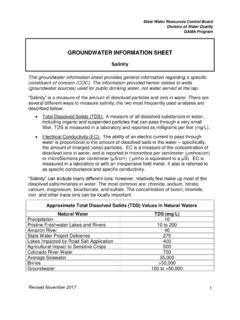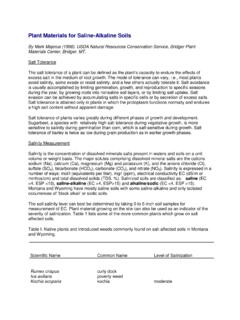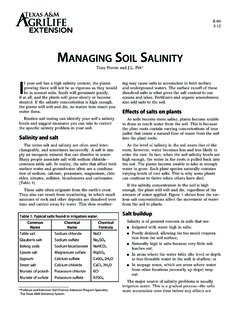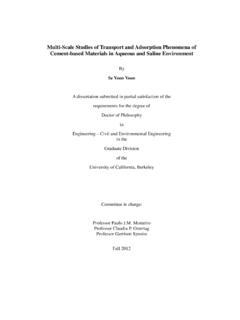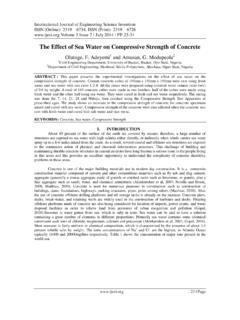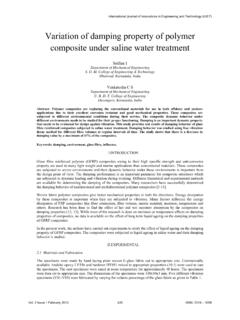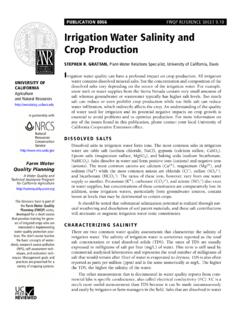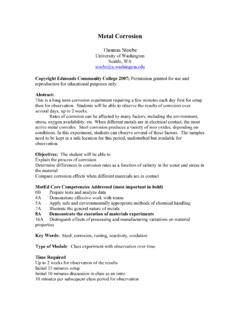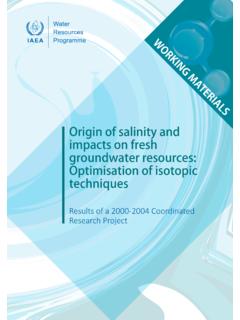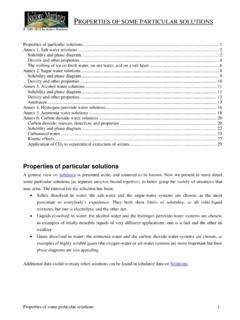Transcription of Quality of Water for Making Concrete: A Review of Literature
1 International Journal of Scientific and Research Publications, Volume 5, Issue 1, January 2015 1 ISSN 2250-3153 Quality of Water for Making Concrete: A Review of Literature Mr. K. J. Kucche*, Dr. S. S. Jamkar**,Dr. P. A. Sadgir** * ME (Structural Engg.)Student, Govt. College of Engineering Aurangabad, Maharashtra-431005, India. **Associate Professor, Dept. of Applied Mechanics, Govt. College of Engineering Aurangabad, Maharashtra-431005, India **Associate Professor, Dept. of Civil Engineering, Govt. College of Engineering Aurangabad, Maharashtra-431005, India Abstract- This paper reviewsthe literaturerelated to Quality of Water for Making allowablelimitsof physical and chemical impurities and the test methods of their evolution are limits of impurities as perIndian, Australian, American and British standardsarepresented.
2 From the Literature it is seen that, the reaction between Water and cement affect the setting time, compressive strength and also lead to softening of concrete . All the impurities may not have adverse effect on the properties of concrete . The use of impure Water for concrete mixing is seen to favorable for strength development at early ages and reduction in long term strength. Index Terms- Alkalinity, compressive strength, flexural strength, magnesium chloride, setting time, pH value. I. INTRODUCTION oncrete is one of the most durable construction material and Cement is one of the most energy intensive structural materials in principal considerations on the Quality of mixing Water are related to performance in fresh as well as harden Quality of the Water plays an important role in the preparation of concrete .
3 Impurities in Water may interfere with the setting of the cement and may adversely affect the strength and durability of the concrete also. The chemical constituents present in Water may actively participate in the chemical reactions and thus affect the setting, hardening and strength development of addition to that, health issues related to the safe handling of such Water must be considered. The suitability of Water can be identified from past service records or tested to performance limits such as setting times and compressive strength and durability test. Limits are specified for mixing Water with their constituents such as total alkalis, chloride sulfate etc.
4 Biological treatment and pathogen reductions are also ensure safety in handling of reclaimed Water and saline Water . F M Lea[1]specified that,pure Water decomposes the set cement compounds, by dissolving the lime and alumina from cement. This action of leaching is continues and then after slows down till the Water is able to pass continuously through the mass of concrete . Water which are acidic owing to the presences of uncombined carbon dioxide, of organic or inorganic acids, are more aggressive in their action, the degree and rate of attack increases as the acidity increases. In general, acid solutions which attack cement mortars or concrete by dissolving part of the cement do not cause any expansion, but progressively weaken the material by removal of cementing constituents forming soft and mushy mass.
5 Paulo and etal[4] specify that, any Water with pH value less than may be aggressive in there action because of, a reduction of the alkalinity of the pore fluid would, eventually lead to removal of the cementitious material. However, the rate of chemical attack will be function of the pH of the aggressive fluid and the permeability of concrete . When the permeability of concrete is less and the pH of the fluid is above 6, the rate of chemical attack is too slow. Again the chemical attack on concrete results into detrimental physical effects, such as porosity, decrease in strength, cracking and breaking into pieces. There are various existing and new sources of Water available which may be suitable for complete or partially replacement of potable Water for concrete Making .
6 It includes reclaimed Water , groundwater, treated Water from sewerand Water from ready mix concrete plant etc. Due to the shortage and scarcity of Water in many part of the world and especially in arid regionslike Qatar and Dubai, Water authorities are moving towards identifying new sources of Water . In these countries,treated effluents are being used for irrigation purpose as well as for concrete mixing, curing and washing of aggregates also. Water from stream, river and even sea is also suitable, if it not contain brackish matter. One of the facts that in arid countries, desalinated Water blended with brackish ground Water used for concrete Making purpose and for Making concrete slurry also.
7 Some important definitions; C International Journal of Scientific and Research Publications, Volume 5, Issue 1, January 2015 2 ISSN 2250-3153 a) Potable Water : Water which is suitable for consumption of human being. b) Recycled Water : Water which is treated up to acceptable limit which is suitable for its intended use. c) Blackish Water : Waste Water generated from toilet, urinals which are directly contaminated with human excreta. d) Gray Water : Waste Water from wash basins, showers, laundries and kitchen. II. Literature Review Limits and guidelines from standards; 1) IS 3025-1984[5] Methods of sampling and test for Water and waste Water . 2) IS 456-2000[6]Plain and reinforced concrete - code of practice.
8 3) AS 1379-1997[7]Specification and supply of concrete . 4) ASTM C94-1996[8]Specification for ready mixed concrete . 5) ACI 318M-08[9]Building code requirements for structural concrete and commentary. 6) ASTM 1602M-06[10]Standard test method for mixing Water used in the production of hydraulic cement concrete . 7) EN 1008-2002(E)[11]Mixing Water for concrete Specification for sampling, testing and assessing the suitability of Water , including Water recovered from processes in the concrete industry, as mixing Water for concrete . IS 3025[5] recommended that, testing of Water play an important role in controlling the Quality of cement concrete work. Systematic testing of the Water helps to achieve higher efficiency of cement concrete and greater assurance of the performance in regard to both strength and durability.
9 Wateris susceptible to being changed due to physical, chemical or biological reactions which may take place between at the time of sampling and analyzing. Hence it is necessary to test Water before used for cement concrete production. Samples should be collected, as far as possible, from midstream at mid depth, Sites should be selected such thatmarginalchanges inwater observed with naked eyes, where there are major river discharges or obstructions occurred, sample from 100maway of the discharge point in downstream side is taken for small case of long length river there should be at least three fixed sampling locations along the locations can be fixed with reference to significant features In case of waste Water form sewersand narrow effluent channels, samples should be drawn from one third Water depths from the top without skimming the top or scrapping the bottom.
10 Velocity of flow at the sampling point should be sufficient to prevent the deposition of solids. Sample should be drawn gently without causing aeration or liberation of dissolved gases. In most cases, sewage flows are intermittent and hence collection of sample at every hour is necessary. Waste waters usually decompose rapidly at room temperature, therefore, certain test setups, such as dissolved oxygen, sulfides, residual chlorine, nitrite and pH should be fixed atsite. For certain other tests, preservatives should be added immediately to individual sample. AS 1379[7]recommended that, mixing Water shall be drawn from a source of acceptable Quality . Acceptable Quality of Water is, Water from ready mix concrete plant in washout operations, may be used as mixing Water if it is stored such as to prevent contamination by deleterious matters to concrete and the Water drawn from the storage outlet.










